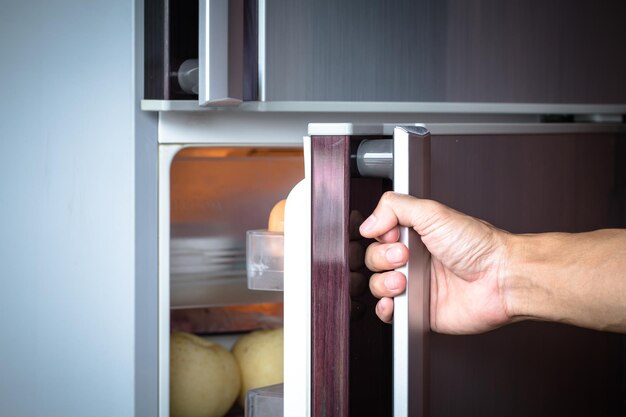Secure Your Belongings: A Complete Guide to Locking a Mini Refrigerator
In today’s age, mini refrigerators have become an indispensable appliance in a multitude of settings—be it college dorms, offices, or personal bedrooms. Even though they are smaller than their full-sized counterparts, they house many items that you may wish to keep secure, whether it's your favorite snack, your lunch, or some expensive skincare products. Hence, the need to lock a mini refrigerator becomes essential, especially in shared environments. This guide provides everything you need to know to ensure your belongings remain secure in a mini fridge, introducing practical tips, insights, and options available for effectively locking your mini refrigerator.
Why Lock a Mini Refrigerator?
Protection Against Food Theft
One of the most common reasons for locking a mini fridge is to prevent food theft. In shared spaces like dorm rooms or offices, individuals may find it tempting to snack on others' food items. Securing your fridge ensures that your sustenance remains yours alone.
Safety of Medicines and Prized Items
Mini refrigerators are often used to store sensitive items like medication, skincare products, or other perishables that can be expensive or require consistent temperatures. Locking your fridge prevents unauthorized access that could potentially disrupt the storage conditions of these items.
Childproofing Measures
If you're in a household with children, a locked mini fridge prevents them from accessing items not meant for them, helping to enforce boundaries and protect them from consuming inappropriate substances.
Preventing Unauthorized Usage
In visitor-frequent spaces, securing your refrigerator ensures that guests don't unintentionally or intentionally use your food and drink supplies.
Exploring Locking Solutions
Built-in Locks
Advantages:
- Convenience: Fridges with built-in locks are ready for use right out of the box.
- Aesthetic Appeal: The lock is integrated, maintaining the sleek design of the fridge.
Limitations:
- Limited Availability: Not every mini fridge model offers a built-in locking option.
- Limited Customization: You're limited to the locking mechanism provided by the manufacturer.
External Locks for Mini Refrigerators
Many models come without built-in locks, but fear not; external solutions offer another layer of security.
Refrigerator Lock Kits
These kits include everything required to install an external lock:
- Adhesive-based Locks: Easy to install and remove without needing to drill. Ideal for those who rent and cannot modify appliances permanently.
- Drill-based Locks: Provides a more permanent solution and tends to be more secure.
Padlock with Chain or Strap System
A more DIY solution, this involves looping a padlocked chain or heavy-duty strap around the fridge:
- Customization Flexibility: Allows adjustment to various fridge sizes and types.
- Affordability: Generally inexpensive and widely available.
Note: This option may not be aesthetically pleasing but is practical for borderline secure conditions.
Considerations Before Lock Installation
Assessing the Space and Equipment
Before deciding on a locking mechanism, examine the location and space where the mini fridge resides. Consider dimensions, the impact on the surrounding furniture, and access logistics for unlocking.
Choosing the Right Lock Style
- Key-based Locks: Offer traditional security.
- Combination Locks: Eliminate the risk of lost keys.
- Childproof Locks: Specifically designed with children’s safety in mind, preventing access via complex unlocking mechanisms.
Legal and Practical Considerations
- Lease Agreements: If in a rented property, check with the landlord regarding appliance modification.
- Sharing Agreements: Communicate with roommates or family about fridge use and access.
Installing a Lock on a Mini Refrigerator
Step-by-Step Guide for Adhesive Lock Installation
- Clean the Surface: Wipe the area where adhesive will go with a mild cleaner; let dry completely.
- Place the Lock: Adhere one side of the lock to the fridge door and the other half to the side panel.
- Secure the Mechanism: Ensure the lock is fastened properly to prevent the fridge from opening if pulled.
Installing a Drill-based Lock
- Mark the Spot: Use a marker to note where you intend to secure the lock.
- Drill Holes: Carefully drill into the marked spots, ensuring not to damage internal wiring.
- Attach the Lock: Screw the lock system into place and test its functionality.
Maintaining and Monitoring Fridge Security
Regularly Check Lock Integrity
Frequently inspect the lock for wear and tear or any tamper signs. Regular usage could weaken adhesives, while metal components may endure rust.
Limit Access Communication
Consider limiting access to those who truly need it. Inform trusted individuals about the lock code/combo or key location, minimizing the risk of misuse.
Upgrade and Replace as Necessary
Technology and product designs constantly evolve. Keep an eye out for better locking solutions or upgrade to cater to your evolving security needs.
Quick Tips for Locking Your Mini Fridge
📌 Identify Your Needs: Whether it’s food safety, childproofing, or privacy, determine why you need the lock before purchasing.
🔒 Choose Wisely: Match your fridge type and personal preference for the lock system—built-in, adhesive, strap, or chain.
🛠️ Proper Installation: Carefully follow installation guidelines to ensure maximal security. Incorrect setup can lead to inefficiency!
Themes to Keep in Mind
Security doesn't have to be complicated. With various solutions available, locking your mini refrigerator is simple with the right steps. Secure your investments and create peace of mind, knowing that your belongings are protected against unauthorized access.
Pursuing the most suitable locking option for your mini refrigerator can ensure you maintain both function and peace of mind. Ultimately, achieving the perfect balance ensures a more secure and harmonious shared living environment or personal space, enhancing the utility and comfort of your daily appliances.
